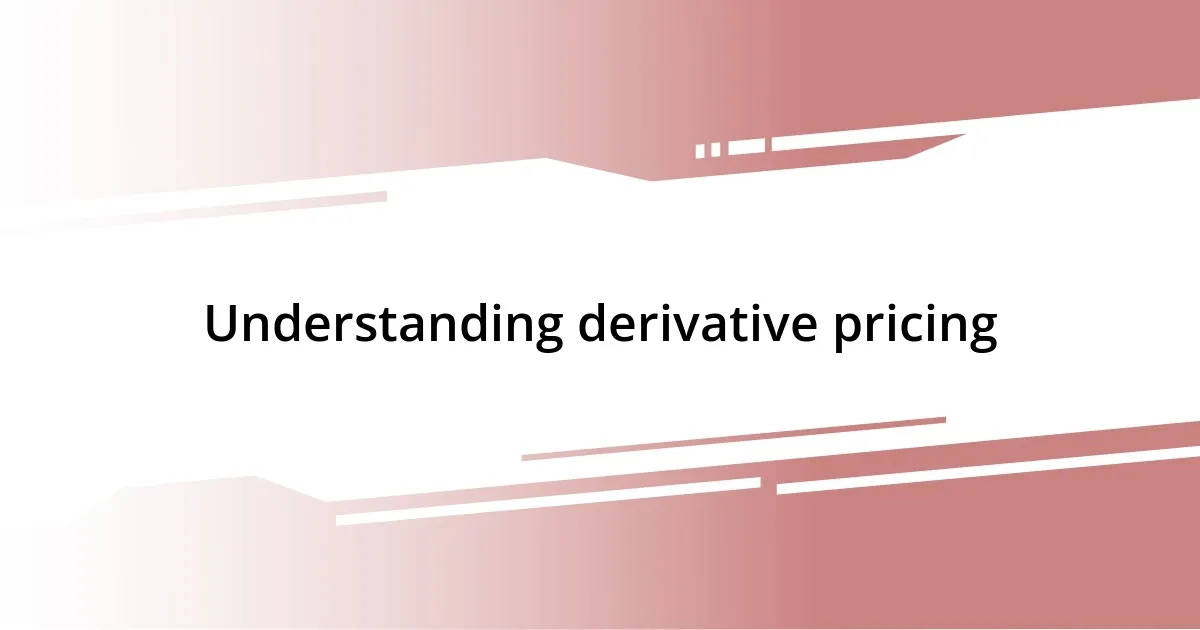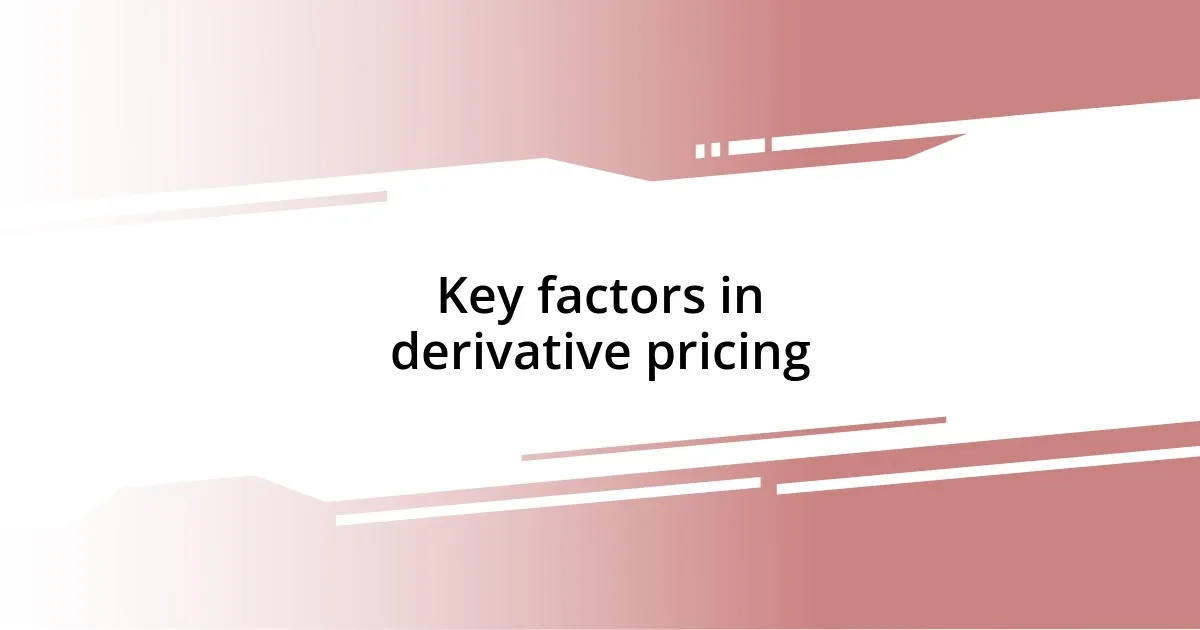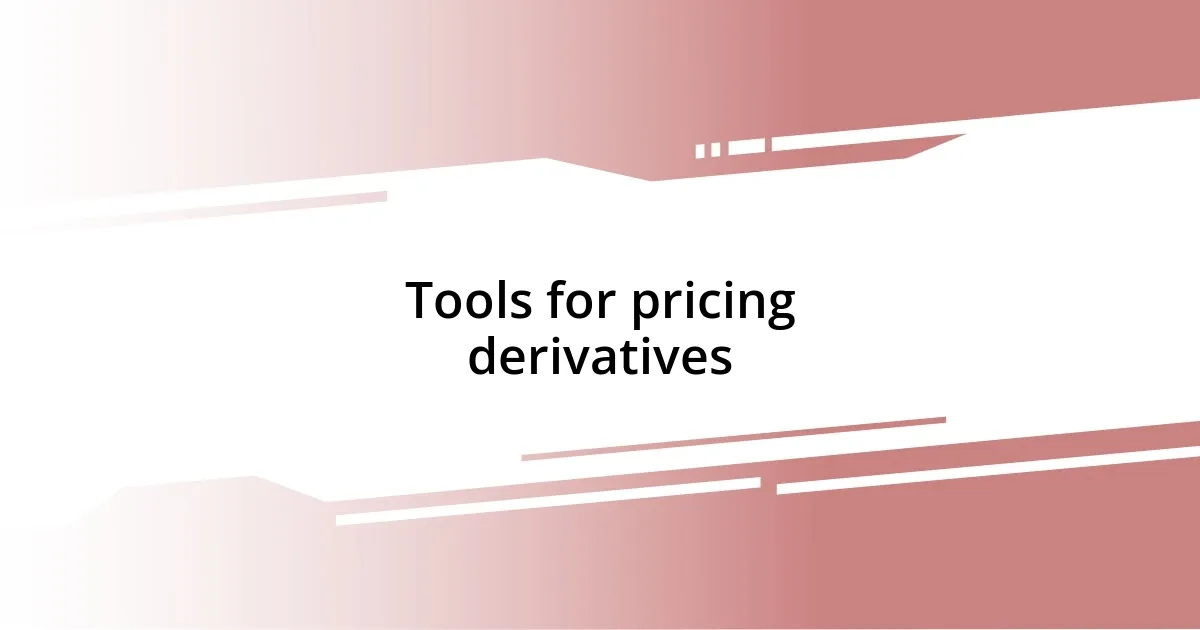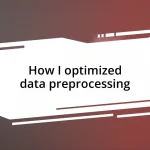Key takeaways:
- Understanding implied volatility and market sentiment is crucial for accurate derivative pricing.
- Choosing the right pricing model depends on the asset characteristics and market conditions, not just numbers.
- Continuous learning and adaptability are essential, as market dynamics constantly evolve.
- Simplicity in pricing processes often leads to better clarity than overcomplicating with multiple models.

Understanding derivative pricing
Understanding derivative pricing can feel like navigating a maze, especially for someone just starting out, like I was. I vividly remember my first encounter with the Black-Scholes model; it seemed almost magical how a mathematical formula could encapsulate so many market factors. Have you ever tried to break down something complex and found yourself lost in the details?
Pricing derivatives involves grasping concepts like implied volatility and the underlying asset’s movements. I recall the moment I realized that volatility isn’t just a number; it reflects market sentiment and expectations. This realization transformed my approach. Suddenly, I started asking myself, “How do traders view this asset? What are they anticipating?”
When pricing derivatives, it’s essential to consider both theoretical and market-driven aspects. My first experience taught me that while theory provides a framework, the real world is dynamic and often doesn’t follow the neatly scribbled lines of academic formulas. I felt a thrill in understanding that, sometimes, intuition about market behavior could equal, if not surpass, rigid calculations. Isn’t that the exciting part of finance—blending art with science?

Key factors in derivative pricing
When I first dived into derivative pricing, understanding the underlying asset was a game-changer. The performance of the asset significantly influences the value of the derivative. I still remember staring at charts for hours, trying to decipher trends, and the moment I found a correlation that clicked. Did you ever dive deep into a single asset trying to understand its movements? That’s where you really start to feel the pulse of the market.
Implied volatility stood out as another key factor in my pricing strategy. Initially, I thought volatility just meant random price swings. But as I began predicting market behavior, I learned it embodies traders’ expectations and can sway pricing significantly. I can’t stress enough how understanding this changed my perspective. The best tools are only as good as your ability to read the sentiment behind them. Have you experienced that eureka moment about a concept that suddenly made everything connect?
Additionally, keeping an eye on interest rates and time decay is crucial. I remember grappling with how these factors interacted with my derivative prices. Time decay, or theta, was particularly intriguing. The idea that the value of options could diminish as their expiration approached felt counterintuitive at first. Yet, understanding it helped me make informed decisions. I found myself constantly asking—how much time do I want to give this trade to develop?
| Key Factor | Explanation |
|---|---|
| Underlying Asset | The value and performance of the asset greatly influence derivative pricing. |
| Implied Volatility | Reflects market expectations and can substantially affect the value of options. |
| Interest Rates | Changes can impact the pricing of derivatives, particularly in financial markets. |
| Time Decay (Theta) | The reduction in an option’s value as it nears expiration. |

Choosing the right pricing model
Choosing the right pricing model for your first derivative can seem daunting, but it ultimately comes down to understanding your specific needs. I recall feeling overwhelmed by the variety of models available, but I learned that each model serves a distinct purpose. For instance, while the Black-Scholes model provided a solid starting point, it didn’t account for the particular nuances of my asset. It was like trying to fit a square peg in a round hole. Selecting a model requires me to consider the characteristics of the asset and the market conditions.
Here are some models you might consider:
- Black-Scholes: Best for European options on non-dividend-paying stocks.
- Binomial: Useful for American options, allowing for multiple exercise opportunities.
- Monte Carlo Simulations: Ideal for complex derivatives with path-dependent features.
- Finite Difference Methods: Offers flexibility in various market conditions and dimensions.
As I explored these models, it became clear that the choice wasn’t just about the numbers; it was about aligning the model’s strengths with my trading philosophy and risk appetite. I learned that the right model complements my understanding rather than complicating it further, fostering a sense of confidence in my pricing decisions.

Common mistakes to avoid
One of the most common mistakes I made was overcomplicating the pricing process. At first, I thought that using multiple models and complex formulas would give me an edge. In reality, it only muddled my understanding. Have you ever found yourself trying to impress others with the latest techniques, only to realize simplicity often leads to clarity?
Another pitfall I often encountered was neglecting to assess the influence of market sentiment on my pricing. I remember times when I based decisions solely on historical data, ignoring how traders felt about current events. That’s when I would miss out on crucial signals. Have you ever analyzed a situation with all the right tools but still felt like something was off? Trust your instincts; they can guide you where data might falter.
Finally, underestimating the importance of continuous learning was a major oversight. I thought the knowledge I gained from my first few trades was sufficient. However, the markets are always evolving, and so should your approach. Reflecting back, I wish I had sought more feedback and education sooner. How often do we let our initial success blind us to the need for growth?

Tools for pricing derivatives
There are several powerful tools I found essential for pricing derivatives that helped me navigate the complexities of the market. One tool that stood out to me was Excel, thanks to its accessibility and flexibility. I vividly remember building my first pricing model on a simple spreadsheet. With every formula I entered, my confidence grew, as I could see how adjustments impacted the outcome. Have you ever experienced the exhilaration of watching your basic calculations unfold into meaningful insights?
Another important tool is computational software, such as R or Python, which offers advanced capabilities for modeling and data analysis. I remember feeling both intimidated and excited when I first dove into Python’s libraries. The ability to run Monte Carlo simulations for my derivatives fascinated me, allowing for deeper insights into risk and uncertainty. Have you ever unlocked a new skill that transformed your understanding? Those moments of discovery are priceless as they illuminate paths you never realized existed.
Finally, I cannot stress enough the significance of market data platforms. Tools like Bloomberg or Reuters provided me real-time information that was crucial for making informed decisions. Once, I relied on delayed data and ended up mispricing a derivative, which taught me a harsh but invaluable lesson about the importance of timely information. Isn’t it interesting how sometimes our biggest learning moments come from our missteps? Embracing the right tools not only streamlines the pricing process but also cultivates a deeper understanding of the dynamic market landscape.

Real-world examples of pricing
When I first started pricing derivatives, I often referenced case studies from financial literature that detailed how seasoned traders approached it. One example that stuck with me was a trader who successfully priced an options contract using implied volatility data from the market. It was a lightbulb moment for me, realizing that I could derive value from the same market signals that experienced professionals relied upon. Have you ever felt inspired by someone else’s success? That kind of insight can spark new ideas on your journey.
I also had an eye-opening experience during a market simulation competition in college. We were tasked with pricing a series of financial instruments, and I decided to lean heavily on the Black-Scholes model for my options. To my surprise, my initial pricing was way off. After some reflection and research, I learned that adjusting for current market sentiment and recent volatility made all the difference. Who knew that a bit of flexibility could transform results dramatically? It taught me to never accept a model’s output at face value.
Later, while managing a small portfolio, I made the mistake of sticking rigidly to historical pricing trends. I remember a night when I stayed up analyzing charts, convinced that past performance would guide me. However, an unexpected market shift occurred the next day, and I found my derivatives priced disproportionately. This taught me a crucial lesson: real-world pricing requires an adaptive mindset and continuous reevaluation. Have you ever struggled with letting go of a preconceived notion? Sometimes, flexibility is the key to success.














